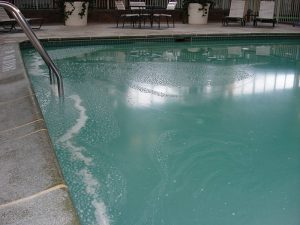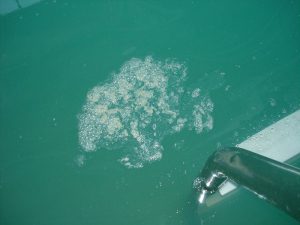Almost every aquatics industry professional has likely heard stories about the use of enzymes in water maintenance and for solving water quality problems. Many have also probably asked themselves along the way what, exactly, are enzymes? In performing a quick Google search on the word itself, one would likely come across the following Wikipedia answer:
Enzymes are large biological molecules responsible for the thousands of chemical interconversions that sustain life. They are highly selective catalysts, greatly accelerating both the rate and specificity of metabolic reactions from the digestion of food to the synthesis of deoxyribonucleic acid (DNA). Most enzymes are proteins, although some catalytic ribonucleic acid (RNA) molecules have been identified. Enzymes adopt a specific three-dimensional structure and may employ organic (e.g. biotin [vitamin H or coenzyme R]) and inorganic (e.g. magnesium ion) cofactors to assist in catalysis.
If this description seems a bit confusing, do not be alarmed. After scrolling down a little further, and conducting a web query on what enzymes really do, one can actually yield a much more simple description. For example:
In enzymatic reactions, the molecules at the beginning of the process, called substrates, are converted into different molecules, called products. Almost all chemical reactions in a biological cell need enzymes in order to occur at rates sufficient for life. Since enzymes are selective for their substrates and speed up only a few reactions from among many possibilities, the set of enzymes made in a cell determines which metabolic pathways occur in that cell.
An everyday example

An example of non-living organic pollutants that are so extreme they actually form a slick on the surface of the water.
To provide a tangible, everyday example of what occurs between an enzyme and its substrate, think about it like the ring of keys one would carry everywhere they go to open various locks throughout their daily routine. Each of these keys will only open the lock for which it was specifically designed. Likewise, enzymes (keys) are specific as to what they are capable to catalyze (bacteria).
In relating this idea to swimming pool and hot tub maintenance, it is easy to understand how the formulation of an enzyme product is important to its application. For example, there are some enzymes that are formulated to focus heavily on non-living organic contaminants (e.g. sweat, lotion, urine, and sunscreen), which is introduced by bathers at an extremely high rate while swimming. Other enzyme products are designed to focus more on environmental factors (e.g. pollen, bird droppings, or even jet fuel that may land in those backyards located near an airport), which may cause water quality problems.
A technical explanation
In general, like all catalysts, enzymes work by lowering the activation energy (Ea) for a reaction, thus dramatically increasing the rate of the reaction. As a result, products are formed faster and reactions reach their equilibrium state more rapidly. Most enzyme reaction rates are millions of times faster than those of comparable un-catalyzed reactions. As with all catalysts, enzymes are not consumed by the reactions they catalyze, nor do they alter the equilibrium of these reactions. However, enzymes do differ from most other catalysts in that they are highly specific for their substrates. In fact, enzymes are known to catalyze approximately 4,000 biochemical reactions. A few RNA molecules called ribozymes also catalyze reactions, with an important example being some parts of the ribosome.
Enzyme activity can be affected by other molecules. Inhibitors are molecules that decrease enzyme activity; activators are molecules that increase activity. For example, many drugs and poisons are enzyme inhibitors. Activity is also affected by temperature, pressure, chemical environment (e.g. pH), and the concentration of substrate. Some household products use enzymes to speed up biochemical reactions (e.g. enzymes in biological washing powders break down protein or fat stains on clothes, while enzymes in meat tenderizers break down proteins into smaller molecules, making the meat easier to chew).
Enzymes in aquatics

After adding enzymes, the slick begins to breakdown and the foaming is the carbon dioxide (CO2) being released during this process.
In applying this to the aquatics industry, and to put it into simple terms, enzymes significantly speed up the natural biodegradation process of non-living organic waste, thus helping to catalyze or breakdown bacteria in swimming pool and hot tub water more quickly. Non-naturally grown enzymes are formulated to react with and continuously break down non-living organic waste into smaller molecules until they are reduced to their elemental constituents—either carbon dioxide (CO2) or water (H2O).
Enzymes are a natural substance and have been around since the earth has been spinning. The modern definition of an enzyme seems to have been discovered in 1833 when French chemist Anselme Payen discovered the first enzyme, ‘diastase.’ A few decades later, while studying the fermentation of sugar to alcohol by yeast, Louis Pasteur came to the conclusion this fermentation was catalyzed by a vital force contained within the yeast cells called ‘ferments,’ which were thought to function only within living organisms. It was later discovered that enzymes function outside as well as within living organisms.
There is no question that swimming pool and hot tub water can benefit from the use of enzymes. While this statement is supported by the growth of enzyme products in the industry in recent years, it also makes sense to first take a closer look at the problems for which they can be used.
What is polluting pool and hot tub water?
Multiple manufacturers within the pool and hot tub industry teamed up to collect real world water samples of some of the most heavily used pools and hot tubs in North America (e.g. crowded health clubs and public pools) to see precisely what was polluting the water. Only once the true culprits were identified could more precise and powerful enzyme blends be created to best combat the issue of non-living organic contamination.
For example, some enzymes in broad spectrum blends are more reactive with fats and oils, while other blends are more effective at helping to break down ammonia-based compounds. The results of this type of broad spectrum enzyme blend yields thousands of potential reactions on non-living organic pollutants. It is the most effective way to break down the root cause of many of the most plaguing symptoms in pool and hot tub water.
In doing so, the final product is actually brewed from various botanical extracts, resulting in the appearance of a very dark brewed tea. Therefore, in order for the consumer to get the most bang for their buck when it comes to enzyme products, they should seek a broad-spectrum blend of enzymes specifically designed to meet the needs of pool and hot tub water treatment.
What are non-living organics?
The term ‘non-living organics’ is used quite often in the aquatics industry (in fact, it has already been used several times in this article); therefore, before going any further, it is important to understand what this term actually means.
Non-living organic contaminants is a term used to describe the vast and varied array of pollutants that are constantly introduced to pool and hot tub water via rain, wind, dust, dead plant matter and other botanicals (e.g. pollen, leaves, etc.). The primary culprit of non-living organic contamination, however, is bather waste in the form of sweat, lotion, sunscreen, and urine. It does not matter how clean a bather is, everyone leaves a little something behind when they exit the water. Non-living organic contaminants—whether environmental or from bathers—can wreak havoc on pool and hot tub water maintenance.
Proper amounts of sanitizer will keep the water free from disease and bacteria, keeping bathers safe from illness, while elevating the sanitizer level (i.e. shocking or super-chlorinating) may oxidize (i.e. chemically burn) some of the non-living organic contaminants out of the water. However, when it comes to setting the stage for the highest quality and the safest pool and hot tub water, the benefits of enzymes are abundantly clear.
What is the difference between sanitation and oxidation?
Sanitation is the killing of viruses, bacteria, and algae on contact, while oxidation is the elimination of non-living organic contaminants.
Chlorine (Cl) is an excellent sanitizer and is meant to provide a residual in the water. Some problems, however, can be encountered when it is used alone to eliminate non-living organic contaminants. For instance, when chlorine encounters a non-living organic compound, it becomes incorporated into the compound and it cannot be broken down any further. This is called combined chlorine.
The combining of chlorine with contaminants in the water limits its ability to work as it is designed, thus it becomes less of a functional sanitizer, making it difficult to keep a residual of ‘good’ chlorine in the water. These (combined) chlorinated organic compounds also form waterline rings, clog filters, and result in the formation of soft scale.
Further, chlorinated compounds that are formed from sweat and urine (chloramines) are responsible for the obnoxious chlorine odor, as well as skin and eye irritation that may be experienced by bathers. As these chloramines form, more and more chlorine is needed to establish a sufficient free-chlorine residual in the water. This is known as shocking or super-chlorination.
Knowing the detrimental effect that non-living organic contaminants have on water, one must also realize the rate at which these contaminants are entering pools and hot tubs. For instance, the vast majority of adults would never reuse someone else’s bath water, yet many bathers skip the shower prior to entering a swimming pool or hot tub. A thorough shower with soap helps remove perspiration, body oils, cosmetics, and traces of urine and fecal matter on the body prior to swimming. Sending these contaminants down the shower drain goes a long way toward reducing the ‘yuck factor’ for everyone who shares the pool.
There is much more to consider, however. The pre-swim shower also helps to minimize the irritating smell of combined chlorine (chloramines). Many people identify this smell as if the facility is using too much chlorine when in fact it is the inefficient combined chlorine previously discussed. In fact, a well-managed and balanced pool will not have any strong chemical odors.
While it is wishful thinking to imagine every single bather will adopt the pre-swim shower routine, the proactive use of enzyme maintenance products by swimming pool and hot tub professionals can significantly decrease potential water quality problems. Although it is hard to control what bathers add to the water, the consistent use of enzymes makes it easier to control what is removed, thus saving time, money, and the headaches of dealing with potential problems when they arise.
This article was written by Chris Marcano and originally appeared on Pool & Spa Marketing [link].
